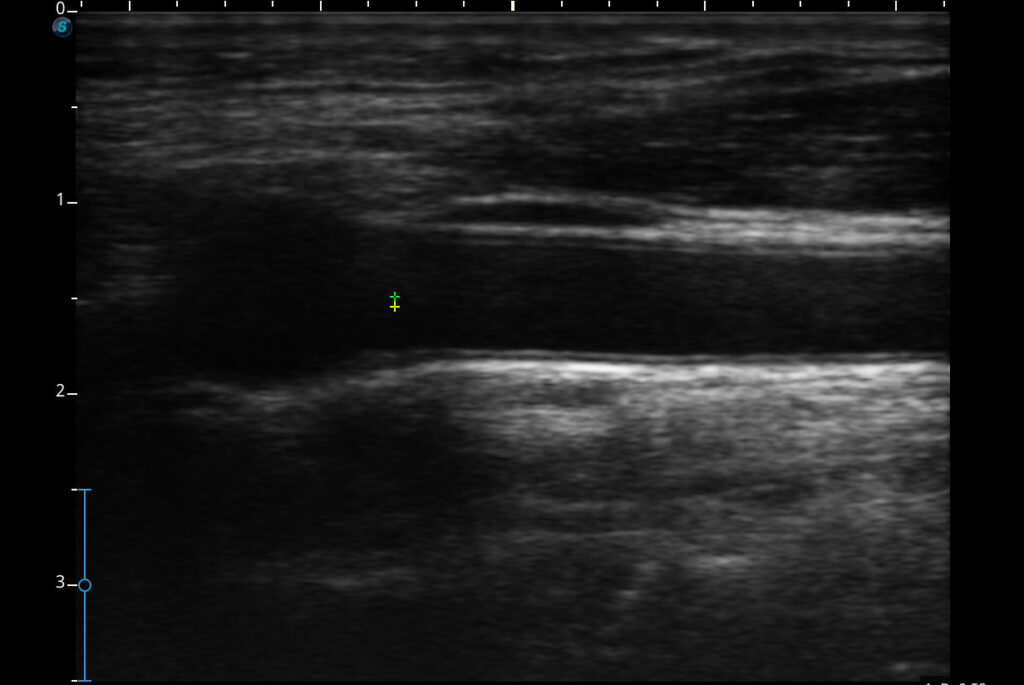What is Carotid Intima Media (CIMT) Testing?.
CIMT caught 98.6% of the heart attacks and strokes BEFORE they occurred in a 10-year, 100,000 person-year study.
Many patients suffering the early and intermediate stages of atherosclerosis show no outward signs or symptoms of the disease.
As many as 50% of those who died from CAD had no prior signs or symptoms.
As many as 50% of those who died from CAD had cholesterol levels that met current guidelines.
What If...
You could look inside your patients’ arteries to see if they were covered in plaque?
You could not only see the atherosclerotic burden, but could also predict your patient’s risk of experiencing a heart attack, stroke, or other ischemic event.
You could measure the degree of inflammation in the arterial wall or the size of the plaque that may contribute to the most common cause of death in America–heart disease?
You Can!
Measuring the thickness of the intima and media layers of the carotid artery wall (carotid intima-media thickness, or CIMT) is one way to assess the cardiovascular health of your patients. This non-invasive procedure gives you another tool in your toolbox to further solve the diagnostic puzzle and help you you accurately assess disease presence, risk of events, and progression of the disease before your patient presents with acute symptoms.
IMT Solves a Very Real Problem
The Framingham algorithm is a great tool for assessing patients at high and low risk for CAD. Establishing a treatment protocol for these patients is also relatively straightforward. However, what do we do for those patients who are at intermediate risk for CAD and who are asymptomatic? The standard of care says we should treat the symptoms of disease. Unfortunately, this may be grossly inadequate because many of these patients are already full of soft plaque (i.e. significant atherosclerosis), and have IMT measurements that place them at very high risk for an ischemic event. Though many physicians will be uneasy with the uncertainty of the Framingham risk assessment in this medium risk group of patients, they will follow the standard of care and avoid aggressive pharmacological treatment in favor of maintaining a vigilant eye on these patients instead. Others will send these patients on for additional testing such as MRI, Stress Echo, or EBCT. Because very few of these patients will have more than 60% stenosis, they will pass the Stress Echo and MRI. EBCT is a great tool for assessing calcified plaque, but is inadequate at identifying the soft and more vulnerable plaque. Many of these patients still have significant amounts of soft plaque lining their arteries. Soft plaque (or echoluscent plaque) of any size has been shown to increase the odds ratio of an ischemic event nearly 2.5 times higher than a person who has an old MI. (Honda, et al J AM Coll Cardiol 2004; 43:1177-84)
Measuring CIMT by Ultrasound

CIMT measurements using B-mode (brightness mode) ultrasound have been performed since the mid-1980s. Using structural B-mode ultrasound, a trained sonographer can easily and non-invasively acquire images of the carotid artery wall for analysis, typically the region immediately proximal to the bifurcation. Upon examination via ultrasound, the adventitia shows up as a bright, white layer and the blood-filled lumen shows up as a black area, allowing the clinician to isolate the area of interest in between . . . the IMT. CardioRisk’s sonographers are all trained to use our patented protocol using patented software. A CardioRisk trained and experienced sonographer can complete the procedure in just under 15 minutes of your patient’s time.

How It Works:
CardioRisk is a service company. No investment is required to offer this test to your patients. There is no need to purchase additional equipment or train additional staff.
To get started, simply call us at our toll-free number: 1-888-724-7484.
Set a date for scanning at your office (usually 3-5 weeks in advance to give you time to gather enough patients).
Begin speaking to at-risk patients about the procedure and suggest they come in for the test. Provide each patient with the IMT patient materials.
CardioRisk will call to confirm the number of patients you have scheduled (Three weeks and one day before your scheduled day). Physicians may want to participate in our free doctor-to-doctor web conference for practical clinical and interpretation information.
A trained CardioRisk sonographer will arrive at your office 15 minutes before the scheduled time. Assign them to an appropriate exam room where the lights can be dimmed (in order to better see the ultrasound screen).
You will receive two copies of each patient’s reports (one for the physician and one for the patient) within 10 business days of the scan. Soft copies (PDF format) are also available. The CardioRisk interpretation guide will come with each batch of reports. Physicians normally meet with each patient again to review results.
Validated and certified sonographers
Ultrasound equipment
IMT software
Patient brochures
Wall charts for exam rooms
Physician-to-Physician Consultation & Training/Live Web Conference
Billing assistance
IMT documentation and studies
Best Practices documentation
Exam Room on the scheduled day
Schedule patients every 15 minutes
Billing for the procedure
Invoice due to CardioRisk in 30 days
CardioRisk charges a modest scanning fee per patient.
Unsurpassed Quality
CardioRisk Laboratories’ technicians are trained to the highest standards using prescribed training methodologies, then measured against a controlled and validated standard available exclusively through CardioRisk. Each element of potential variability is measured through strict protocols and tested biannually. Statistical coefficients of variability are calculated by academic biostatisticians at the University of Utah Medical School. This calibration and standardization is completed at regular intervals so you don’t need to worry about the consistency or reproducibility of your patient’s test results. Our highly trained specialists can be scheduled at your convenience, at your office. You receive the results for each patient within days of the scan.
Covered Expense
Many major insurance carriers and Medicare are currently reimbursing some or all of the cost for this critical test in at-risk patient populations. The test is much more specific and predictive of heart attack, stroke, and myocardial infarction than are many more expensive tests. The exam is recommended by the American Heart Association for adults over 45, and the software has received FDA clearance .
CardioRisk Laboratories aims to facilitate and standardize the process of testing for heart disease.
Doctor Testimonials
"CardioRisk Laboratories is a necessary and great collaborative partner for my practice providing me with reliable and precise reports on the CIMTs for my patients."
Dr. Eric A. Goulder, MD, FACC
"Dr. Todd Eldredge is a source of truth, defended with a thorough understanding of clinical research statistics, voluminous knowledge of cardiovascular risk factor testing methods and study results, and passion for respectful, vigorous debate so patients get the most effective interventions to reduce cardiovascular morbidity and mortality."
Dr. Stephen Sims, MD
"Dr. Todd Eldredge helped save my life with his knowledge, expertise, and experience. I was headed for a Cardiovascular Episode, but now I'm on the road to recovery & wellness."

